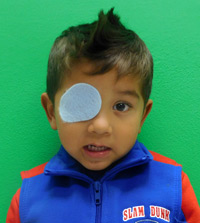Our patches are designed for treatment of Amblyopia which requires total vision deprivation of the sound (good) eye to increase the vision of the Amblyopic eye. Made right here in El Paso the cost is $8.49 per box of 30 patches plus shipping.
 Placement of the patch on the sound (good) eye.
Placement of the patch on the sound (good) eye.
The patch should be angled so the more narrow part crosses above the bridge of the nose and the wider base is on the cheekbone and temporal bones of the eye. If the right eye is being patched the narrow part of the patch should be angled towards the left eyebrow with the wider section towards the right jawbone. If the left eye is being patched the narrow part should be angled towards the right eyebrow and the wider section towards the left jawbone.
Help! My toddler won’t keep the patch on!
If you and your toddler are new to patching, you will quickly discover that keeping the patch on an active, non-compliant toddler will seem difficult. PERSEVERE! The magic number is three.
The first three days will be difficult as your unhappy toddler yanks off the patch and you replace it numerous times. Typically, it gets easier after three days because as the vision improves in the lazy eye, your toddler will become more used to wearing the patch and tolerate it much better.
What if my child still won’t keep the patch on his good eye?
You can try limiting your child’s ability to reach the patch. Arm restraints worn on the arms and over the elbow restricts the child’s ability to reach the face, but allows the hands to remain free for play. Cloth arm restraints are available for purchase in medical supply stores or over the internet. Less expensive options include swimming floaties, empty cardboard paper towel rolls (for a proper fit, you may need to cut the tubes lengthwise and then tape the two pieces), or a couple of empty Pringles canisters – just cut the ends off and remove the metal ring!
How do you keep the patch on an active 5 year old?
At this age it will require a lot of parental control and creativity. As the parent, you are in charge – patching is not a democratic decision! Use a reward system. The promise of a favorite activity or treat is a great incentive in exchange for a period of good patching. Resorting to bribery is encouraged if your child will wear the patch!
Wouldn’t it just be easier to postpone patching until my child is older and able to understand why it is necessary to wear a patch?
A child’s brain is very flexible until it becomes “hard-wired” at around the age of 8 years. When your child is only a second grader the visual system has reached adulthood! Therefore, the younger the child is when patching of the good eye is begun, it becomes more likely that the vision in the lazy eye will improve to a normal, or near normal, level. So despite the fact that your toddler cannot understand why the vision in his better seeing eye has disappeared by covering it with a patch, the visual benefits to be gained in the long-term by eliminating his Amblyopia at a young age are ultimately well worth the aggravation!
I read in a magazine about using eye drops in the good eye instead of patching.
Yes, in certain situations, a drop called “Atropine” may be substituted for the patch. Atropine dilates the pupil and paralyzes the focusing mechanism of the eye for 2 to 3 weeks. As it is so long lasting, children with lightly colored eyes may need only one drop in the good eye every other day. (Children with darker eyes may require a daily drop).
Atropine should be reserved for older children who are self-conscious about wearing a patch, children with skin conditions where patches applied directly to the skin cannot be used, and children with mild degrees of Amblyopia (“lazy vision”).
